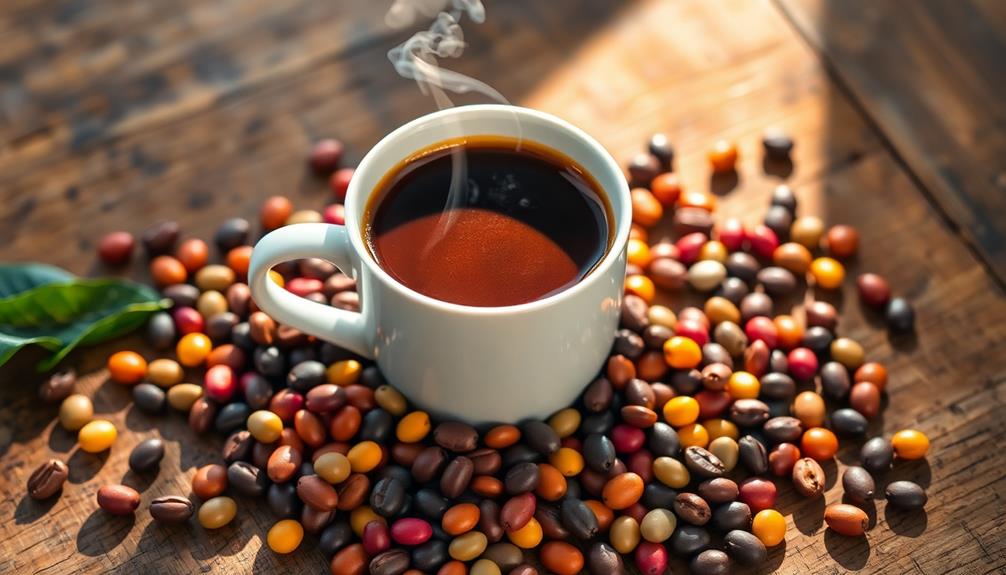Coffee Alternatives And Tea
How to Make Coffee Substitute From Wheat

I have always had a fondness for coffee, but as of late, I have been searching for healthier and gentler substitutes to consume. This led me to the discovery of the incredible variety of wheat-based coffee alternatives.
Not only do they provide a rich and satisfying flavor, but they also offer a range of health benefits. In this article, I’ll guide you through the process of making your own wheat coffee substitute, from choosing the right type of wheat to grinding techniques and flavor variations.
Get ready to embrace a delicious and nutritious alternative to your morning cup of joe!
Key Takeaways
- Wheat coffee is a caffeine-free alternative to traditional coffee, making it suitable for those looking to reduce their caffeine intake.
- Wheat coffee is a rich source of vitamins, minerals, and antioxidants, offering a healthier option for your daily beverage.
- Different types of wheat, such as hard wheat and soft wheat, offer distinct flavor profiles, allowing you to choose the one that suits your preferences.
- Roasting wheat grains to different levels (light, medium, or dark) can enhance the flavor of your coffee substitute, providing a mild, balanced, or bold taste.
The Benefits of a Coffee Substitute Made From Wheat
You’ll love the benefits of a coffee substitute made from wheat. Wheat coffee offers a great alternative to traditional coffee, especially for those who want to reduce their caffeine intake. One of the main advantages is that wheat coffee is naturally caffeine-free, which means you can enjoy a cup without worrying about the jitters or sleepless nights.
Additionally, it is a rich source of vitamins, minerals, and antioxidants, providing a healthier option for your daily beverage. Wheat coffee also has a milder and smoother flavor compared to traditional coffee, making it a great choice for those who prefer a more subtle taste.
Choosing the right wheat variety is essential to ensure the best flavor and aroma in your coffee substitute. Transitioning into the next section, I will discuss how to choose the right type of wheat for your coffee substitute.
Choosing the Right Type of Wheat for Your Coffee Substitute
When it comes to choosing the right type of wheat for your coffee substitute, there are two key factors to consider: the nutritional benefits and the flavor profiles.
Wheat is a nutrient-dense grain that is rich in fiber, protein, vitamins, and minerals, making it an excellent choice for a healthy coffee alternative.
Additionally, different types of wheat, such as hard wheat and soft wheat, offer distinct flavor profiles that can enhance the taste of your coffee substitute.
Nutritional Benefits of Wheat
The nutritional benefits of wheat include being a good source of dietary fiber and providing essential vitamins and minerals. Wheat is a versatile grain that can be used in various forms, including flour alternatives and gluten-free options.
For those seeking alternatives to traditional wheat flour, there are several options available, such as almond flour, coconut flour, and quinoa flour. These alternatives are gluten-free and can be used in baking and cooking to create delicious and nutritious dishes.
Additionally, wheat itself can be processed to remove the gluten, making it suitable for individuals with gluten sensitivities or celiac disease. It is important to note that wheat is also rich in nutrients like iron, magnesium, and B vitamins, which are essential for maintaining overall health and well-being.
Flavor Profiles of Wheat
Wheat has a unique range of flavors, including nutty, earthy, and slightly sweet notes. These flavors make wheat a versatile ingredient for flavor pairing in various dishes and beverages.
When it comes to brewing techniques, wheat can be used in different forms to create a range of flavors. Here are some ways to incorporate wheat into your brewing process:
-
Wheat malt: Using malted wheat can add a nutty and slightly sweet flavor to your beer or ale.
-
Wheat flour: Adding wheat flour to your bread or pastry recipes can enhance the earthy and nutty flavors.
-
Wheatgrass: Juicing wheatgrass can provide a fresh and grassy taste, perfect for smoothies or health shots.
-
Wheat tea: Steeping wheat grains or leaves can create a soothing herbal tea with a unique flavor profile.
How to Properly Roast Wheat for a Coffee-Like Flavor
When it comes to creating a coffee-like flavor with wheat, the roasting process plays a crucial role. By properly roasting the wheat, you can enhance its flavor and achieve a more robust and aromatic coffee substitute.
This discussion will delve into the steps involved in roasting wheat for a coffee-like flavor, the resulting taste profile, and how it can be prepared as a coffee alternative.
Roasting Process for Flavor
To enhance the flavor of your coffee substitute, you’ll want to start by roasting the wheat grains. Roasting is a crucial step in developing the rich and aromatic taste of your wheat coffee. Here are some roasting techniques and flavor development tips to help you achieve the best results:
- Light Roast: Roast the wheat grains at a low temperature for a shorter duration to achieve a mild and delicate flavor profile.
- Medium Roast: Increase the temperature and roasting time slightly to develop a balanced and slightly nutty taste.
- Dark Roast: Roast the grains at a higher temperature and for a longer time to obtain a bolder and more robust flavor.
- Experiment with Different Times and Temperatures: Adjust the roasting process to find your preferred level of flavor intensity.
By using these roasting techniques, you can create a wheat coffee substitute that perfectly suits your taste preferences.
Now, let’s explore the unique taste of wheat coffee and its similarities to traditional coffee.
Wheat Coffee Taste
Using different roasting techniques can help me achieve a variety of flavors in my wheat coffee.
When it comes to the taste of wheat coffee, it can vary depending on the roasting process. Lighter roasts tend to have a milder and more delicate flavor, while darker roasts can bring out a stronger, richer taste. It’s important to find the right balance that suits your preferences.
In terms of health benefits, wheat coffee is a great alternative to regular coffee as it is caffeine-free and contains essential nutrients like fiber, protein, and antioxidants.
To make wheat coffee, I can grind roasted wheat berries and brew it just like regular coffee. Adding a dash of cinnamon or nutmeg can enhance the flavor even more. It’s a delicious and healthy option for coffee lovers.
Coffee Alternative Preparation
You can prepare a delicious alternative to regular coffee by grinding roasted wheat berries and brewing it just like you would with your favorite coffee. Here are some tips for choosing brewing techniques and the benefits of caffeine-free options:
-
Grinding: Use a coffee grinder or a food processor to grind the roasted wheat berries into a fine powder. This will ensure a smooth and consistent texture for your wheat coffee substitute.
-
Brewing: Brew the ground wheat berries using a coffee maker or a French press. Add hot water to the coffee maker or the French press, then add the ground wheat and let it steep for a few minutes. Press the plunger or strain the liquid to remove any sediment.
-
Flavoring: You can enhance the flavor of your wheat coffee substitute by adding spices like cinnamon or nutmeg, or sweeteners like honey or maple syrup.
-
Benefits: Caffeine-free options like wheat coffee can provide a soothing and comforting alternative to regular coffee. It is also a great choice for those who are sensitive to caffeine or looking to reduce their caffeine intake.
Enjoy your caffeine-free wheat coffee substitute and savor the benefits it offers!
Grinding Techniques for Creating a Fine Wheat Powder
For a finer wheat powder, try adjusting the grinder setting to a finer setting and allowing the wheat to pass through multiple times. Grinding techniques play a crucial role in achieving the perfect texture for your wheat powder.
When using a grinder, it is important to choose the right setting to ensure that the wheat is ground to the desired consistency. By adjusting the grinder to a finer setting, you can create a finer powder.
Additionally, running the wheat through the grinder multiple times helps to further break down the grains, resulting in a smoother and finer texture. It is important to be patient and experiment with different settings and grinding times to find the perfect balance for your wheat powder.
Exploring Flavor Variations With Added Ingredients
I love experimenting with different flavor combinations to enhance the taste of my dishes. Adding unique ingredients can truly elevate the overall flavor profile and make a dish more exciting.
Additionally, using spices is a great way to add depth and complexity to any recipe, allowing you to create a truly flavorful experience.
Creative Flavor Combinations
Adding spices such as cinnamon and nutmeg to your wheat coffee substitute can create delicious flavor combinations. Not only do these spices add warmth and depth to your drink, but they also offer a range of health benefits.
Here are four creative flavor pairings to experiment with:
-
Vanilla and Cardamom: The sweet and floral notes of vanilla paired with the warm and citrusy flavors of cardamom create a harmonious blend that is both soothing and uplifting.
-
Ginger and Turmeric: Adding a touch of ginger and turmeric to your wheat coffee substitute can provide a spicy kick and a vibrant golden color. Both spices are known for their anti-inflammatory properties.
-
Coconut and Almond: Combining the creamy richness of coconut with the nutty sweetness of almond brings a tropical twist to your drink. It’s a perfect combination for those who enjoy a hint of indulgence.
-
Peppermint and Chocolate: For a refreshing and decadent flavor, try adding a dash of peppermint extract and a sprinkle of cocoa powder. This combination will satisfy your cravings for a minty-chocolate treat.
Enhancing Taste With Spices
To enhance the taste of your beverage, try experimenting with different spices. Spices have been used for centuries to add flavor and depth to traditional coffee. Not only do they enhance the taste, but spices also offer several health benefits.
For example, cinnamon is known for its antioxidant properties and can help regulate blood sugar levels. Adding a pinch of nutmeg can provide a warm and comforting aroma, while also promoting digestion. Cardamom, another popular spice, has been used in Ayurvedic medicine for its anti-inflammatory properties. Ginger, with its spicy and refreshing flavor, can aid in digestion and reduce inflammation.
Brewing Methods for a Tasty Wheat Coffee Substitute
First, start by choosing a brewing method that suits your taste preferences for the wheat coffee substitute. There are several brewing techniques you can try to achieve a delicious cup of wheat coffee. Here are some options to consider:
-
French press: This method involves steeping coarsely ground wheat in hot water for a few minutes before pressing down the plunger to separate the grounds.
-
Pour-over: With this method, you pour hot water over a filter containing medium-coarse ground wheat, allowing it to slowly drip into your cup.
-
Espresso machine: If you prefer a stronger and more concentrated flavor, using an espresso machine with finely ground wheat will give you a rich and bold cup.
-
Cold brew: For a refreshing alternative, cold brewing involves steeping coarsely ground wheat in cold water for several hours, resulting in a smooth and less acidic beverage.
In addition to the various brewing techniques, wheat coffee substitute also offers health benefits such as being rich in fiber, vitamins, and minerals. It is a great source of antioxidants and may help improve digestion and boost metabolism.
Enhancing the Aroma of Your Wheat Coffee Substitute
When it comes to enhancing the aroma of your wheat coffee substitute, there are several methods you can try. One approach is to experiment with different roasting techniques. By adjusting the temperature and duration of the roasting process, you can bring out unique flavors and aromas in your substitute. Another way to enhance the aroma is by adding natural ingredients such as cinnamon, vanilla, or nutmeg to your brew. These spices can complement the wheat flavor and create a delightful scent. Lastly, you can explore flavor variations by blending different grains or adding herbs like chicory or dandelion root. This will not only enhance the aroma but also introduce new flavors to your wheat coffee substitute.
| Methods | Benefits |
|---|---|
| Experimenting with roasting techniques | Brings out unique flavors and aromas |
| Adding natural ingredients like cinnamon or vanilla | Complements wheat flavor and creates delightful scent |
| Blending different grains or adding herbs | Introduces new flavors to wheat coffee substitute |
Tips for Achieving a Rich and Smooth Texture
One way you can achieve a rich and smooth texture is by using a French press to brew your substitute. Here are some tips for achieving smoothness and alternative textures:
-
Grind your wheat coffee substitute finely: A finer grind will extract more flavor and create a smoother texture in your beverage.
-
Use hot water, but not boiling: Boiling water can make the substitute taste bitter. Aim for water around 200°F (93°C) to maintain a smooth and balanced flavor.
-
Steep for the right amount of time: Letting the substitute steep for too long can result in a bitter taste. Follow the recommended steeping time for the best texture and flavor.
-
Stir gently: Stirring the substitute gently during brewing can help to extract flavors evenly and enhance the smoothness.
By following these tips, you can achieve a rich and smooth texture in your wheat coffee substitute.
Now, let’s explore some serving suggestions and creative uses for this delightful beverage.
Serving Suggestions and Creative Uses for Wheat Coffee Substitute
To enhance the flavor and versatility of your wheat coffee substitute, try experimenting with different sweeteners and spices. Adding a touch of sweetness can balance the earthy taste of wheat and make it more enjoyable. Consider using natural sweeteners like honey, maple syrup, or stevia for a healthier option. As for spices, cinnamon, nutmeg, or cardamom can add a warm and aromatic twist to your drink.
When it comes to serving suggestions, you can enjoy your wheat coffee substitute hot or cold, just like regular coffee. You can also add a splash of almond milk or coconut milk for a creamy texture. If you’re feeling creative, try using your wheat coffee substitute as a base for smoothies or homemade energy bars. The possibilities are endless!
In addition to its delicious taste, wheat coffee substitute offers several health benefits. It is caffeine-free, which means you can enjoy it without the jitters or sleep disturbances associated with traditional coffee. It is also rich in fiber, vitamins, and minerals, making it a nutritious choice.
Storage and Shelf Life of Homemade Wheat Coffee Substitute
If you’re wondering how long your homemade wheat coffee alternative will last, store it in an airtight container in a cool, dry place to ensure optimal shelf life. Here are some storage tips and the best containers to use:
-
Airtight Containers: Use glass jars with rubber seals or resealable bags to keep your wheat coffee substitute fresh and prevent moisture and air from getting in.
-
Cool and Dry Place: Store your homemade wheat coffee substitute away from direct sunlight and heat sources. A pantry or cupboard is an ideal location.
-
Avoid Freezing: While freezing may seem like a good option, it can affect the flavor and texture of your wheat coffee substitute. It’s best to store it at room temperature.
-
Label and Date: To keep track of freshness, label your containers with the date you made the wheat coffee substitute. This will help you know when it’s time to make a fresh batch.
Frequently Asked Questions
Can I Use Any Type of Wheat to Make a Coffee Substitute?
Yes, you can use different types of wheat to make a coffee substitute. It offers various health benefits like providing energy, antioxidants, and dietary fiber. However, it’s important to consider individual preferences and any potential allergies or sensitivities.
What Are Some Common Flavor Variations I Can Try With My Wheat Coffee Substitute?
When it comes to flavor combinations for my wheat coffee substitute, I love experimenting! From adding a dash of cinnamon for warmth to a hint of vanilla for sweetness, the possibilities are endless. Plus, it offers great health benefits!
Are There Any Special Brewing Methods I Should Use for My Wheat Coffee Substitute?
For my wheat coffee substitute, I found that using special brewing equipment like a French press or espresso machine enhances the flavor. Experimenting with alternative brewing methods, such as cold brew or pour-over, can also yield delicious results.
How Can I Enhance the Aroma of My Wheat Coffee Substitute?
To enhance the aroma of my wheat coffee substitute, I can try different roasting techniques like light, medium, or dark roast. Additionally, adding spices such as cinnamon or nutmeg can also add a delightful fragrance.
How Long Can I Store My Homemade Wheat Coffee Substitute and What Is Its Shelf Life?
Storing homemade wheat coffee substitute is vital for maintaining its freshness and flavor. Proper storage, like an airtight container in a cool, dry place, can extend its shelf life. Additionally, this substitute offers health benefits like antioxidants and fiber.
Conclusion
In conclusion, making a coffee substitute from wheat is a rewarding and versatile alternative for those looking to reduce their caffeine intake or simply try something new. By carefully selecting the right type of wheat, roasting it to perfection, and experimenting with different flavors, you can create a delicious beverage that mimics the taste and aroma of coffee.
With a rich and smooth texture, this homemade wheat coffee substitute is sure to satisfy even the most discerning coffee lover. So why not give it a try? Remember, the proof is in the pudding!
Arf, an author and an innovative enthusiast of coffee, coffee alternatives, and tea, plays a crucial role as a contributor to the esteemed Cappuccino Oracle platform. Renowned for his curiosity and passion for these captivating beverages, Arf has carved out a unique space for himself in the world of exploration and writing. He realized that coffee, coffee alternatives, and tea are not mere drinks to keep one awake, but universes of flavors and stories waiting to be explored.
Arf’s articles for Cappuccino Oracle blend meticulous research with personal experiences, providing readers with an in-depth understanding of various types of coffee, coffee alternatives, and tea, along with their unique characteristics, cultures, and histories. His honest reviews and engaging narratives guide readers on their own journeys, helping them discover their preferences and find their perfect brew.
Coffee Alternatives And Tea
The ‘Miracle Bean’ That’s Making Coffee Obsolete
Just when you thought coffee couldn’t get any better, a revolutionary beanless blend is transforming your morning ritual—discover the future of your coffee experience.

The 'miracle bean' is shaking up your morning routine with its sustainable, beanless blend made from upcycled date seeds and chicory. Startups like Atomo create coffee alternatives that not only rival traditional brews in taste but also greatly reduce environmental impact. In blind taste tests, many preferred this innovative option over existing brands. As consumers increasingly shift towards eco-friendly choices, beanless coffee stands ready to fill the gap left by traditional options constrained by climate change and other challenges. You won't want to miss what this shift means for your coffee experience moving forward.
Key Takeaways
- The rise of beanless coffee, made from upcycled ingredients like date seeds, offers a sustainable alternative to traditional coffee.
- Beanless coffee brands like Atomo outperform conventional options in taste tests, indicating high consumer satisfaction.
- Environmental concerns drive consumers toward beanless coffee, which has a significantly lower water and carbon footprint compared to traditional coffee farming.
- Climate change threatens coffee production, prompting a shift in consumer preferences towards innovative and sustainable coffee alternatives.
- The unique flavor profiles and comparable caffeine levels of beanless coffee challenge the dominance of traditional brews in the market.
The Rise of Beanless Coffee

Emerging from a growing demand for sustainability, beanless coffee is reshaping how we think about our morning brew. Innovations from startups like Atomo and Minus are leading the charge, using sustainable ingredients like upcycled date seeds and chicory to create a delicious coffee alternative.
With rising consumer interest in eco-friendly products, beanless coffee offers a viable solution to the challenges posed by climate change and the sustainability of traditional coffee supplies. Additionally, coffee alternatives can still provide health benefits, including antioxidants that combat oxidative stress and may improve mood and cognitive function, making them appealing to health-conscious consumers coffee's health benefits.
Atomo's blend, for instance, combines 50% beanless ingredients with 50% sustainably sourced Arabica, striking a balance between rich flavor and environmental responsibility. Initial taste tests reveal these beanless products often outperform traditional brands, which hints at strong market potential if consumer preferences shift.
As climate change threatens coffee production, predictions show that suitable coffee-growing land could shrink by over 50% by 2050. Within this framework, beanless coffee presents a promising alternative, allowing you to enjoy your daily cup without the environmental impact tied to conventional coffee farming.
With these innovative solutions, your morning ritual can now align with your values, making sustainability a key ingredient in your coffee experience.
Environmental Impact of Coffee Production

Coffee production has a significant environmental impact that's often overlooked in our daily routines. The expansion of coffee plantations contributes to deforestation, which threatens biodiversity and reduces carbon storage. As climate change escalates, suitable coffee-growing land could shrink by over 50% by 2050, jeopardizing farmers' livelihoods and the coffee supply chain.
Here's a quick overview of the environmental impacts associated with coffee production:
| Impact | Description |
|---|---|
| Deforestation | Large areas cleared for coffee plantations |
| Climate Change | Reducing land suitability for coffee growth |
| High Carbon Footprint | Traditional farming practices increase emissions |
| Water Footprint | Coffee cultivation requires significant water |
Additionally, rising temperatures and extreme weather events are driving price spikes and supply challenges, underscoring the unsustainability of traditional coffee farming. You might find it alarming that the average Arabica tree yields only about one pound of coffee annually. Without quality control measures, inadequate harvesting can lead to further spoilage, amplifying the environmental impact. Embracing sustainable coffee practices is essential for mitigating these issues and protecting our planet.
Innovations in Coffee Alternatives

Innovations in coffee alternatives are reshaping how we think about our daily caffeine fix. Startups like Atomo and Minus are leading the way by developing beanless coffee alternatives using sustainable ingredients like upcycled date seeds and legumes.
These products aim to replicate the flavor and caffeine content of traditional coffee while addressing environmental concerns. The rising popularity of sustainable products in various markets aligns with the increasing demand for eco-friendly options, making beanless coffee an attractive choice for many consumers.
Atomo's 50:50 Drip Coffee blend combines 50% beanless coffee with 50% sustainably sourced Arabica, showcasing a significant innovation that minimizes environmental impact without sacrificing taste.
Blind taste tests reveal that Atomo's beanless blend outperformed leading coffee chains by a factor of 2:1, indicating that you're likely to prefer the flavor and quality of these coffee alternatives.
As the growing consumer trend toward sustainable food options continues, beanless coffee has the potential to capture a significant market share.
With traditional coffee supply facing challenges due to climate change and agricultural pressures, these innovative products present a compelling solution.
You might find that opting for beanless alternatives not only satisfies your caffeine cravings but also supports a more sustainable future. Embrace the change and explore the exciting world of coffee alternatives!
Consumer Trends Toward Sustainability

Increasingly, consumers are prioritizing sustainability in their purchasing decisions, and this trend is evident in the rising popularity of beanless coffee alternatives.
As eco-conscious shoppers, you're likely drawn to products that minimize environmental impact. Brands like Atomo and Northern Wonder are leading the charge, emphasizing sustainable ingredients and innovative practices. This shift mirrors the growing interest in sustainable living, including trends like tiny house communities that focus on reducing ecological footprints and maximizing efficiency tiny house living.
Here are a few reasons why you might embrace beanless coffee:
- Reduced Agricultural Waste: Atomo uses upcycled date seeds, cutting down on waste and creating a more sustainable product.
- Lower Water Usage: Northern Wonder's life cycle analyses show their coffee uses up to 1/20th the water compared to traditional coffee.
- Decreased Carbon Emissions: These alternatives emit less than 1/4 the carbon of conventional coffee, appealing to your eco-friendly values.
- Climate-Proof Options: As climate change threatens coffee supply chains, beanless innovations offer a reliable choice for the future.
With coffee enthusiasts allocating 17.5% of their disposable income to sustainable brands, it's clear that consumer trends are shifting.
You're not just enjoying a cup; you're actively choosing a more sustainable lifestyle.
Economic Challenges in Coffee Industry

As coffee production costs rise and climate change wreaks havoc on growing conditions, you might start feeling the pinch at your local café.
The increasing demand for more affordable options may lead consumers to explore alternatives that offer unique benefits, such as transformative effects of glycolic acid, which can enhance overall skin health.
With prices already spiking, many consumers are becoming more price-sensitive, seeking alternatives that won't break the bank.
This shift could reshape your coffee experience, making way for options like beanless coffee to fill the gap left by traditional brews.
Rising Production Costs
How will rising production costs reshape the coffee industry? As you look to your morning brew, you might notice that the landscape of coffee is changing. Rising production costs are squeezing farmers, making it harder for them to maintain profit margins.
Understanding the refrigeration cycle can play an essential role in preserving the quality of coffee during storage and transportation, which is vital as prices rise. Here's what you need to take into account:
- Price Spikes: Extreme weather events have already sent coffee prices soaring, reaching $2.58 per pound in 2022 due to crop failures.
- Profit Margins: Farmers are grappling with razor-thin profit margins, putting their livelihoods at risk.
- Increased Vulnerability: Rising temperatures expose coffee beans to more pests and diseases, further driving up production costs.
- Economic Access: Higher coffee prices could restrict access for lower-income consumers, making your daily cup more expensive.
These pressures are compounded by climate change, which threatens to reduce suitable coffee-growing land by over 50% by 2050.
As coffee cultivation contributes to deforestation, farmers may have to adapt to new growing regions, further escalating long-term production costs. The future of coffee is uncertain, and these challenges could lead to a fundamental shift in how you experience your favorite beverage.
Climate Change Impact
While climate change poses a significant threat to the coffee industry, its impact extends far beyond just rising temperatures. You mightn't realize that projections suggest suitable coffee-growing land could shrink by over 50% by 2050, jeopardizing coffee production and availability.
As temperatures rise, coffee plants become more vulnerable to pests and diseases, which can drastically affect both yields and quality. This mirrors the challenges faced in other agricultural sectors, where energy-efficient systems can mitigate some of the impacts of climate change.
In recent years, extreme weather events like heatwaves and heavy rainfall have already caused significant price spikes in coffee, with prices hitting $2.58 per pound in 2022. Farmers, already facing razor-thin profit margins, struggle to maintain sustainable coffee production amidst these challenges. These economic pressures make it increasingly difficult for them to adapt to the shifting climate landscape.
Moreover, the need to relocate coffee cultivation to new regions due to climate change can lead to further deforestation and environmental degradation, compounding the economic challenges within the coffee industry.
As these factors converge, the future of coffee beans and the livelihoods of farmers hangs in the balance, pushing the industry to reevaluate its sustainability and resilience strategies.
Consumer Price Sensitivity
With rising coffee prices pushing $2.58 per pound, consumers are feeling the pinch more than ever. This surge, driven by extreme weather and escalating production costs, is making you rethink your coffee habits.
As a result, consumer price sensitivity is becoming a significant factor in your purchasing decisions. Many middle-class customers are now exploring alternative options like beanless coffee to save money. Additionally, innovative alternatives such as creative uses for rooibos tea are gaining popularity, providing flavorful and sustainable options.
Here are four reasons why you might consider switching from traditional coffee:
- Affordability: Beanless coffee offers a more budget-friendly option as prices continue to rise.
- Sustainability: With farmers facing pressure due to high coffee prices, beanless alternatives can support more sustainable practices.
- Flavor Variety: Innovations in beanless coffee can introduce new flavors and experiences, broadening your palate.
- Market Trends: As consumer preferences shift, the demand for beanless coffee will likely reshape the coffee industry landscape.
If coffee prices stabilize at these high levels, you might find yourself embracing these cost-effective solutions more than ever.
The future of your morning routine could be beanless, providing a feasible alternative in today's economic climate.
Taste and Quality Comparisons

When you compare the flavor profiles of traditional coffee and Atomo's beanless blend, you'll notice some intriguing differences.
The brewing methods also play a significant role in the final taste, making it essential to explore how each approach influences your cup.
Blind taste tests reveal that many consumers prefer the beanless option, which raises questions about what we really value in our coffee experience.
Flavor Profile Differences
As beanless coffee continues to gain traction, many are discovering its remarkable flavor profile that rivals traditional brews. Products like Atomo's innovative blend have even outperformed conventional coffee in blind taste tests, with a 2:1 preference over leading coffee chains.
You might be surprised by the complexity and richness crafted from upcycled ingredients like chicory and date seeds. In addition to its unique taste, the nutritional power of ingredients used in beanless coffee can contribute to a healthier lifestyle, much like the benefits offered by chia seeds.
Here are four key aspects that highlight the flavor profile differences:
- Smoothness: Many consumers report a velvety texture that enhances the overall drinking experience.
- Unique Flavor Notes: Initial reviews of beanless espresso shots reveal exciting flavors that deviate from traditional coffee, offering something new.
- Caffeine Content: Surprisingly, beanless coffee maintains caffeine levels similar to traditional brews, ensuring you still get your morning boost.
- Eco-Friendly Appeal: As eco-conscious consumers seek sustainable alternatives, the flavors in beanless coffee resonate with their values.
With a focus on quality and taste, beanless coffee could very well shift consumer preferences, especially as traditional coffee faces challenges from climate change.
Brewing Method Variations
Exploring different brewing methods can dramatically change your experience with beanless coffee, just like it does with traditional brews. Each method affects the flavor profile, making some techniques better suited for highlighting the nuanced tastes of beanless coffee.
For instance, pour-over and French press methods may enhance sweetness and body, while espresso and cold brew can accentuate acidity or bitterness. Additionally, the unique ability of chia seeds to absorb liquid can inspire innovative brewing techniques that maximize hydration and flavor extraction, offering a revitalizing twist to your beverage choices chia seeds and digestive health.
Your consumer preference plays an essential role here, as the choice of brewing equipment and practices—including temperature control and extraction time—directly impacts the final taste and aroma of your drink.
With the rise of beanless coffee innovations, companies are experimenting with various brewing methods to replicate that beloved traditional coffee experience without using actual coffee beans.
As you explore these methods, you might find that the innovative techniques for brewing beanless coffee can sometimes outperform traditional coffee, offering a new and exciting alternative.
Whether you prefer a smoother taste or something bolder, the right brewing method can elevate your experience, making every cup unique and tailored to your taste. Embrace the variety that new brewing methods bring to the table!
Blind Taste Test Results
Recent blind taste test results reveal a compelling comparison between beanless coffee and traditional options, particularly highlighting Atomo's innovative blend. In these tests, Atomo's beanless coffee outperformed a leading coffee chain by an impressive ratio of 2:1, showcasing its superior taste and quality.
The rise in popularity of sustainable products, such as beanless coffee, resonates with consumers who are increasingly concerned about the environmental impact of traditional coffee cultivation and production, particularly regarding nutrient absorption and plant importance.
Here are some key findings from the taste tests:
- Consumer Preference: Participants showed a consistent preference for Atomo's blend over traditional coffees.
- Unique Flavor Notes: Many noted distinct flavor profiles in the beanless coffee, enhancing its appeal.
- Sustainability Appeal: Beyond taste, consumers appreciated the eco-friendly aspects of beanless coffees.
- Quality Experience: The results support the idea that beanless coffee can compete with conventional options regarding taste and satisfaction.
These outcomes indicate that coffee companies should take note of consumer preferences shifting towards beanless options.
As more people seek sustainable alternatives that don't compromise on flavor, Atomo's success in these blind taste tests positions it as a strong contender in the coffee market.
It's clear that beanless coffee isn't just a trend; it's a viable alternative that's redefining your coffee experience.
Frequently Asked Questions
What Is the Most Sought After Coffee Bean?
The most sought-after coffee bean is Arabica. You'll appreciate its smooth, mild flavor and lower caffeine content. It thrives in specific climates and can command high prices, especially when sourced from renowned regions.
What Is the Underdog Coffee Bean That's Making a Comeback?
Imagine a coffee bean rising from the ashes like a phoenix—it's the robusta bean! You'll find it thriving in tough climates, boasting higher caffeine, and winning taste tests, proving it's the true underdog of coffee.
What Is the New Coffee Bean Type?
The new coffee bean type isn't actually a bean at all. It's crafted from upcycled ingredients like chicory and barley, aiming to mimic the flavor and caffeine of traditional coffee while promoting sustainability.
What Is Happening to Coffee Beans?
As temperatures rise like a vintage film reel playing fast, you're seeing coffee beans threatened by climate change. Pests and diseases thrive, while suitable land shrinks, driving prices up and production down. It's a brewing crisis.
Conclusion
As you explore the world of beanless coffee, it's clear that this "miracle bean" is changing the game. With its sustainable production and innovative flavors, it's no wonder consumers are jumping on the bandwagon. While the traditional coffee industry faces challenges, the shift towards greener alternatives is gaining momentum. So, if you're looking to sip sustainably, now's the time to embrace this brewing revolution and watch your coffee habits evolve. The future's looking bright!
In the vast and diverse world of coffee, coffee alternatives, and tea, Olivia has found her calling. As an author and a dedicated coffee and tea aficionado, her work for Cappuccino Oracle reflects her profound love and understanding of the intricate complexities found within these beverages. Olivia’s passion for the subject serves as both a catalyst for her creativity and a connection point with her audience.
Olivia’s appreciation for coffee, coffee alternatives, and tea blossomed at an early age. She discovered that these beverages invigorated her senses and stimulated her creative spirit. From the nuanced flavors of single-origin roasts to the captivating narratives intertwined with coffee, coffee alternatives, and tea trade and culture, Olivia found an unlimited source of inspiration in her daily cup.
Her love for these beverages and her talent for storytelling eventually converged at Cappuccino Oracle. As an author, Olivia’s mission is to illuminate the intricate tapestry that makes up the world of coffee, coffee alternatives, and tea. Her articles span a diverse range of topics, encompassing everything from the unique flavors of different brews to the sociocultural history intertwined with their cultivation and consumption.
Coffee Alternatives And Tea
The Tea That’s So Powerful, It’s Almost Illegal
Discover the potent world of teas that defy the norm, where ancient traditions and modern legality collide in surprising ways. What secrets will you uncover?

If you're curious about teas that pack a punch, kava, coca, and yaupon are some of the most powerful. Kava tea offers relaxing, stress-relieving effects without clouding your mind, but be cautious—overconsumption can impair motor skills. Coca tea, rich in antioxidants and mild stimulants, is only legal in certain South American countries, while yaupon carries deep historical significance for Indigenous peoples but is gaining new attention. These teas challenge legal boundaries and conventional wellness practices. Stick around, and you'll uncover more fascinating details about their unique benefits and backgrounds.
Key Takeaways
- Kava tea offers relaxation and stress relief through kavalactones but can impair motor skills if overconsumed or mixed with alcohol.
- Coca tea, while providing mild stimulation and health benefits, is illegal in the U.S. due to its association with coca plants.
- Yaupon tea has historical significance for Indigenous peoples and is experiencing a revival as a culturally rich beverage.
- The kava tea market is growing in the U.S., with increasing interest in natural wellness alternatives among consumers.
- Health marketing for herbal teas emphasizes functional benefits, driving innovation and education in the powerful tea market.
Kava Tea: A Natural Alternative

Kava tea offers a unique and natural alternative for those seeking relaxation without the fog of traditional sedatives. Made from the root of the kava plant, this tea contains kavalactones that deliver sedative and muscle-relaxing effects while maintaining mental clarity.
Traditionally enjoyed in the Pacific Islands, kava tea is revered for its ability to reduce stress and anxiety, making it a popular choice for alleviating work-related stress symptoms, including back pain. Additionally, kava is known to have potential benefits for sleep quality and may enhance overall wellbeing, making it a versatile option for those looking to improve their health and lifestyle consult healthcare provider before including in diet.
As the kava market expands in the U.S., with about 20 kava bars primarily in South Florida, more people are discovering this alternative to alcohol. You'll find that kava tea is typically consumed quickly due to its bitter taste, providing effects within just 10 to 15 minutes.
However, it's important to exercise caution; overconsumption can impair your motor skills, and mixing kava with alcohol isn't recommended.
While kava faced some scrutiny regarding its safety, investigations in the U.S. have shown insufficient evidence to support the initial concerns about liver damage. This clarification opens the door for you to explore kava tea as a viable option for relaxation and stress relief.
The Power of Coca Tea

Coca tea packs a unique punch, offering a blend of mild stimulation and cultural significance. Made from the leaves of the coca plant, this strong cup contains low levels of coca alkaloids, with about 4.2 mg per gram. This means you can enjoy a mild stimulant effect, similar to what you'd get from a strong coffee or tea, without the intense highs associated with cocaine.
Additionally, like cranberry juice, coca tea is rich in antioxidants, which can be beneficial for overall health. For travelers heading to high altitudes, coca tea is a traditional remedy recommended by Andean indigenous peoples. While studies on its effectiveness are limited, many swear by its ability to combat altitude sickness. However, be cautious—consuming coca tea can lead to positive drug test results for cocaine due to its potent alkaloid content.
Although coca tea is legal in countries like Colombia, Peru, Bolivia, and Argentina, it remains illegal in the United States unless decocainized. This legal disparity highlights the complex cultural attitudes towards coca tea, shaped by historical contexts and drug policies.
Embracing this beverage means engaging with both its stimulating properties and its rich cultural legacy.
Yaupon Tea's Historical Significance

Yaupon tea isn't just a beverage; it holds deep cultural roots for Indigenous peoples who used it in rituals and social gatherings, much like how beekeeping practices have been integral to community traditions.
Its historical value stretches beyond tradition, influencing colonial economies as it became a sought-after commodity.
You'll see how its journey from Native practices to European markets showcases its significance in shaping social dynamics.
Indigenous Cultural Practices
For centuries, indigenous communities have cherished yaupon tea, known as cassina, for its invigorating properties and deep cultural significance. This remarkable drink, brewed from the leaves of Ilex vomitoria, served as more than just a beverage; it played a crucial role in various indigenous rituals and social gatherings.
The drink not only enriches the spirit but also enhances emotional resilience, fostering connections to the land and community, much like the power of imagination that transforms personal experiences.
Here are three key aspects of its cultural importance:
- Ceremonial Use: Yaupon tea was often consumed in sacred rituals, fostering spiritual connections and reverence for nature.
- Social Bonding: In communal settings, sharing yaupon tea reinforced relationships and cultural identity among participants, creating a sense of belonging.
- Historical Value: Prior to European colonization, yaupon tea was a pre-Columbian commodity, valued for its stimulating effects and recognized by early colonists as a rival to imported teas.
As the popularity of yaupon tea waned with the rise of imported alternatives, recent revival efforts aim to reconnect modern consumers with its rich cultural roots and health benefits.
Embracing yaupon tea today means honoring the traditions and practices that have sustained indigenous communities for generations.
Colonial Economic Influence
The history of yaupon tea reveals a complex interplay of cultural significance and colonial economic interests. Brewed from the holly species Ilex vomitoria, this tea was cherished by Native Americans long before European settlers arrived. Early colonists recognized its value, but the East India Company's monopoly on imported teas stifled yaupon's commercial potential.
Despite its popularity, colonial economic influence skewed perceptions of this local beverage, as British botanists labeled it based on misunderstandings of indigenous practices. Additionally, the rise of other locally sourced products, such as best beach bags for moms, showcased the potential of native resources that were often overshadowed by foreign imports.
The name "Ilex vomitoria" reflects an attempt to control narratives around commodities that could compete with lucrative imports. During the Civil War, yaupon tea experienced a resurgence as luxury teas became unavailable, yet its association with hardship post-war complicated its reputation.
Today, efforts to revive yaupon tea focus on its historical significance and ethical sourcing, but the tea still faces hurdles from lingering negative perceptions and competition with established imports.
Understanding these dynamics offers insight into how colonial economic influence shaped not just the market but also the cultural landscape surrounding this powerful tea. Embracing its rich history might redefine how you view this unique beverage.
Health Benefits and Risks

When you consider kava tea, you'll appreciate its stress-relief properties that can help you unwind without clouding your mind.
Additionally, it's crucial to recognize that the way you store related herbal products can influence their potency and effectiveness, similar to how storing essential oils in dark glass bottles preserves their quality.
However, it's vital to be aware of the legal status and concerns surrounding its use, especially regarding moderation.
Understanding both the benefits and potential risks can empower you to make informed choices about incorporating kava into your routine.
Kava's Stress-Relief Properties
Kava tea has gained popularity as a natural remedy for stress and anxiety relief, thanks to its unique compounds called kavalactones. When you consume kava tea, you may experience several notable benefits, including a boost in your ability to focus on mindset to attract abundance in career and an enhanced sense of gratitude that can improve your overall well-being.
- Alleviation of Stress Symptoms: Kava tea can help reduce work-related stress, including back pain, allowing you to feel more comfortable and at ease.
- Promotes Mental Clarity: Unlike some other relaxants, kava doesn't cloud your mind; instead, it enhances mental clarity while promoting relaxation.
- Muscle Relaxation: The sedative effects of kava can help relieve muscle tension, making it easier to unwind after a long day.
While kava tea offers these stress-relief benefits, it's essential to approach it with caution. Overconsumption can lead to impaired motor skills and sedation, so moderation is key.
Also, avoid mixing kava with alcohol, as this combination may pose serious risks to your liver health. Although concerns about kava's safety arose in the early 2000s, many of these issues were linked to contaminated sources or pre-existing conditions.
As kava bars gain traction, you can enjoy this powerful tea in a social setting while finding your own path to relaxation.
Legal Status and Concerns
Concerns surrounding kava tea's legal status stem from its potential health risks and benefits. While kava is recognized for its muscle relaxation and anxiety-reducing properties, its link to liver damage led to a ban in the European Union in 2002. Investigations by the CDC and FDA found insufficient evidence to warrant such a ban, suggesting that health issues might stem from pre-existing conditions or contaminated sources.
Here's a quick overview of kava tea's legal status and associated health concerns:
| Aspect | Details | Status |
|---|---|---|
| Health Benefits | Muscle relaxation, anxiety reduction | Supported by research |
| Health Risks | Potential liver damage, impaired motor skills | Needs caution |
| Legal Status | Banned in EU, varied acceptance elsewhere | Evolving views |
| Recent Developments | Germany's reversal of kava ban | Positive shift |
| Consumption Advice | Avoid mixing with alcohol, moderate intake | Recommended |
As the market for kava expands, it is crucial to stay informed about its legal status and health implications.
Cultural Context and Consumption

Coca tea has woven itself into the cultural fabric of the Andean regions, where it's celebrated not just for its mild stimulant effects but also for its rich traditions. This beverage symbolizes much more than a drink; it represents a connection to cultural heritage and community, much like the importance of credit card management in personal finance stability.
When you sip coca tea, you're participating in a long-standing tradition that includes:
- Medicinal Use: Indigenous peoples have historically used coca tea to alleviate altitude sickness, showcasing its significance in local medicinal practices.
- Social Bonding: Sharing coca tea among friends and family fosters a sense of unity and strengthens social ties, making it a staple during gatherings.
- Cultural Identity: For many in the Andes, coca tea embodies their cultural identity, allowing them to connect with their roots and pass down traditions to future generations.
While coca tea remains legal in several South American countries, its status varies elsewhere, like in the U.S., where it's restricted.
This discrepancy highlights differing cultural attitudes towards coca and its consumption, making understanding its significance essential for appreciating its role in Andean life.
The Future of Powerful Teas

The future of powerful teas looks promising as more consumers turn to natural alternatives for energy and wellness. You're likely to see an expanding market filled with innovative blends that combine traditional teas with adaptogens, nootropics, and superfoods.
These powerful teas cater to health-conscious individuals like you, seeking enhanced cognitive and physical performance without the crash associated with energy drinks. As herbal teas are known for their calming effects and health benefits, they'll increasingly be integrated into these blends health benefits of herbal teas.
As cultural interest in wellness grows, expect powerful teas to be marketed not just as beverages but as functional foods. They'll be promoted for their specific health benefits, such as stress relief and improved focus, making them an appealing option for your daily routine.
However, keep an eye on regulatory scrutiny surrounding teas with psychoactive ingredients or high caffeine levels, as this may affect their availability and marketing strategies.
The rise of online retailers and specialty tea shops will also facilitate your access to unique and potent varieties. This trend will drive consumer education, encouraging you to experiment with powerful teas that align with your health goals.
As you explore these options, the possibilities for improving your well-being with powerful teas are endless.
Frequently Asked Questions
What Makes a Tea "Almost Illegal"?
A tea can be considered "almost illegal" if it contains ingredients that are heavily regulated or banned due to their potency or effects. You might find such teas in herbal shops, but be cautious with consumption.
Are There Legal Restrictions on Powerful Teas?
Maneuvering powerful teas is like walking a tightrope. Yes, there are legal restrictions in many places, especially for those containing high caffeine or banned substances. Always check local laws before indulging in something intense.
How Does Caffeine Content Vary Among Different Teas?
Caffeine content in teas varies considerably. Green tea typically has less caffeine than black tea, while matcha can pack a punch. You'll find white tea usually contains lower levels, making it a milder option overall.
Can Powerful Teas Cause Dependency or Withdrawal Symptoms?
It's ironic, isn't it? You sip your favorite tea for calm, yet it can lead to dependency. If you suddenly stop, you might face withdrawal symptoms like headaches or irritability—welcome to the world of powerful brews!
What Are the Best Preparation Methods for Strong Teas?
To prepare strong teas, use freshly boiled water and steep leaves for longer. Experiment with water temperature and adjust the leaf-to-water ratio. You'll discover your perfect brew, maximizing flavor and potency with each cup.
Conclusion
As you sip these potent brews, imagine the ancient rituals and vibrant cultures they spring from, each cup a portal to another world. Kava, coca, and yaupon tea weave tales of strength, history, and healing, inviting you to partake in their rich legacies. But remember, with great power comes responsibility—honor the traditions and tread carefully. In the dance of flavors and effects, you'll find not just a drink, but a connection to the earth and its people.
In the vast and diverse world of coffee, coffee alternatives, and tea, Olivia has found her calling. As an author and a dedicated coffee and tea aficionado, her work for Cappuccino Oracle reflects her profound love and understanding of the intricate complexities found within these beverages. Olivia’s passion for the subject serves as both a catalyst for her creativity and a connection point with her audience.
Olivia’s appreciation for coffee, coffee alternatives, and tea blossomed at an early age. She discovered that these beverages invigorated her senses and stimulated her creative spirit. From the nuanced flavors of single-origin roasts to the captivating narratives intertwined with coffee, coffee alternatives, and tea trade and culture, Olivia found an unlimited source of inspiration in her daily cup.
Her love for these beverages and her talent for storytelling eventually converged at Cappuccino Oracle. As an author, Olivia’s mission is to illuminate the intricate tapestry that makes up the world of coffee, coffee alternatives, and tea. Her articles span a diverse range of topics, encompassing everything from the unique flavors of different brews to the sociocultural history intertwined with their cultivation and consumption.
Coffee Alternatives And Tea
5 Morning Drinks That Make Coffee Look Like Poison
Wake up your mornings with five energizing drinks that outshine coffee—discover the surprising benefits that await you!

If you're looking for morning drinks that make coffee seem dull, try these five options. Start your day with a vibrant green smoothie packed with vitamins and antioxidants. Herbal teas like chamomile and ginger soothe without caffeine jitters. Fresh vegetable juices, rich in nutrients, can boost your performance and support your liver. Coconut water offers hydration and electrolytes, perfect for an active lifestyle. Finally, chia seed drinks provide a steady energy source without sugar spikes. These healthy alternatives not only taste great but also enhance your well-being—stick around to discover even more delicious options!
Key Takeaways
- Green smoothies provide essential vitamins and minerals while being low in calories, promoting weight management and sustained energy without caffeine jitters.
- Herbal teas offer calming effects and antioxidants, providing a caffeine-free alternative that supports immune function and digestive health.
- Fresh vegetable juices are nutrient-dense, low in sugar, and support liver function, making them a heart-healthy replacement for coffee.
- Coconut water hydrates with electrolytes and antioxidants, delivering energy without the crash associated with caffeine.
- Chia seed drinks stabilize energy levels with healthy fats and fiber, keeping you full and hydrated without the stimulant effects of coffee.
Green Smoothies

Green smoothies are often hailed as a vibrant alternative to traditional morning beverages like coffee. While many rely on their daily cup of joe to kick-start their day, you might find that blending leafy greens such as spinach or kale into a smooth drink packs a serious punch of vitamins, minerals, and antioxidants.
These nutrients can boost your overall health and energy levels without the jitters often associated with coffee beans. Incorporating ingredients from meal replacement juices for weight loss can further enhance the nutrient profile of your smoothie, providing essential vitamins while keeping calorie intake low.
By incorporating fruits, seeds, and nut butters, you can enhance the flavor of your green smoothie while adding essential nutrients and healthy fats. Plus, the high fiber content aids in digestion and detoxification, making these smoothies a smart choice for anyone looking to improve their gut health.
Unlike your typical coffee, green smoothies are generally low in calories and sugar, making them a healthier option for weight management. The chlorophyll in those vibrant greens can also improve oxygen transport in your body, promoting sustained energy throughout the day.
Herbal Teas

For those seeking a soothing alternative to morning coffee, herbal teas offer a delightful array of flavors and health benefits. These caffeine-free brews not only taste great but also support your well-being in various ways.
When you sip on herbal teas like chamomile or peppermint, you can enjoy their calming effects while aiding digestion. Rooibos tea, in particular, is celebrated for its rich antioxidant content and unique flavor profile, making it a fantastic choice for health-conscious individuals unique taste variations.
Here are some herbal tea benefits to take into account:
- Rich in Antioxidants: Varieties like rooibos and hibiscus help combat oxidative stress, promoting overall health.
- Anti-inflammatory Properties: Ginger and turmeric teas can support your immune function and reduce inflammation in your body.
- Detoxifying Effects: Nettle and dandelion teas are known for their ability to help cleanse your body from toxins.
- Diverse Flavors: You can infuse herbal teas with various ingredients, allowing you to customize your drink for calming effects or digestive aids.
With so many options available, herbal teas can easily become a comforting, health-promoting part of your morning routine.
Fresh Vegetable Juices

Kickstart your morning with fresh vegetable juices that pack a powerful nutritional punch. These vibrant drinks, made from ingredients like carrots, beets, and spinach, are loaded with vitamins, minerals, and antioxidants, making them a nutrient-dense alternative to coffee.
When you sip on vegetable juice, you're not just hydrating; you're also providing your body with essential nutrients like potassium and folate, which boost your overall health and energy levels. Incorporating exotic fruit blends into your vegetable juice can elevate the flavor and nutritional value, making your morning routine even more delightful.
Beet juice, in particular, has gained attention for its ability to enhance athletic performance. Its high nitrate content improves blood flow, giving you a natural energy boost that rivals your morning cup of joe.
Plus, juicing can help detoxify your body, thanks to the enzymes and phytonutrients that promote liver function and effectively eliminate toxins.
With fresh vegetable juices being low in calories and sugar, they present a heart-healthy option for anyone aiming to reduce caffeine intake.
Coconut Water

There's something invigorating about coconut water that coffee simply can't replicate. When you sip on this natural beverage, you're not just quenching your thirst; you're also nourishing your body.
With its low-calorie count and essential electrolytes like potassium, sodium, and magnesium, coconut water stands out as a perfect hydrating alternative to your morning brew. Additionally, embracing natural beverages like coconut water can help create a positive environment, reducing stress and promoting emotional well-being, much like the benefits of aromatherapy and essential oils.
Here are some fantastic benefits of choosing coconut water:
- Rich in Vitamins: It's loaded with vitamin C and several B vitamins, boosting your overall health and energy levels.
- Lower Caffeine: Coconut water contains minimal caffeine, making it ideal if you're looking to cut back without sacrificing vitality.
- Antioxidant Properties: The antioxidants help combat oxidative stress, promoting better heart health and hydration.
- Aids Digestion: Natural enzymes in coconut water support digestion, enhancing its health benefits compared to traditional coffee.
Switching to coconut water can transform your mornings, giving you a revitalizing lift without the jitters.
Chia Seed Drinks

Elevating your morning routine with chia seed drinks can provide a nutritious and revitalizing alternative to coffee. Packed with omega-3 fatty acids, fiber, and antioxidants, these drinks deliver essential nutrients while keeping your energy levels stable. Unlike coffee, which can cause spikes in blood sugar, chia seeds help maintain a balanced energy boost throughout the day.
Additionally, the nutritional benefits of chia seeds contribute to heart health and digestive wellness, making them a smart choice for your morning beverage.
When you consume chia seed drinks, you're not just hydrating; you're also increasing your fluid intake. Chia seeds absorb water and expand, making you feel fuller for longer. A typical serving of about 2 tablespoons contains roughly 140 calories, 5 grams of protein, and 11 grams of fiber, making it a satisfying option for breakfast or a mid-morning snack.
Customization is where chia seed drinks shine. You can mix them with fruit juices, coconut water, or herbal teas to create invigorating beverages that suit your taste. Plus, you'll avoid the acidity that often comes with coffee.
Frequently Asked Questions
What Can I Drink in the Morning to Replace Coffee?
You can try matcha for a calm boost, herbal teas for a invigorating start, or golden milk for its anti-inflammatory benefits. Fresh juices and nutrient-packed smoothies also provide delicious, energizing alternatives to coffee.
What Drink Has the Same Effect as Coffee?
Did you know that yerba mate contains about 85 milligrams of caffeine per cup? If you're looking for a drink with the same effect as coffee, you'll find yerba mate's energizing properties quite impressive!
What Is the Most Unhealthy Coffee Drink?
The most unhealthy coffee drink often comes from popular chains, loaded with syrups and whipped cream. These can exceed 1,000 calories and 60 grams of sugar, making them a poor choice for your health.
Why Is My Morning Coffee Making Me Sick?
If your morning coffee feels like a bitter storm brewing inside you, it might be due to low-quality beans, contaminated water, or toxins. Consider switching to filtered water and sourcing organic coffee for relief.
Conclusion
As you sip on these vibrant alternatives, you'll feel like you're bathing in a rainbow of health. Each drink brings its own unique benefits, transforming your morning ritual into a nourishing experience. Say goodbye to the jitters of coffee and embrace the gentle energy these beverages provide. Whether you crave the invigorating taste of herbal tea or the energizing burst of a green smoothie, you're sure to find a drink that revitalizes your spirit and fuels your day.
In the vast and diverse world of coffee, coffee alternatives, and tea, Olivia has found her calling. As an author and a dedicated coffee and tea aficionado, her work for Cappuccino Oracle reflects her profound love and understanding of the intricate complexities found within these beverages. Olivia’s passion for the subject serves as both a catalyst for her creativity and a connection point with her audience.
Olivia’s appreciation for coffee, coffee alternatives, and tea blossomed at an early age. She discovered that these beverages invigorated her senses and stimulated her creative spirit. From the nuanced flavors of single-origin roasts to the captivating narratives intertwined with coffee, coffee alternatives, and tea trade and culture, Olivia found an unlimited source of inspiration in her daily cup.
Her love for these beverages and her talent for storytelling eventually converged at Cappuccino Oracle. As an author, Olivia’s mission is to illuminate the intricate tapestry that makes up the world of coffee, coffee alternatives, and tea. Her articles span a diverse range of topics, encompassing everything from the unique flavors of different brews to the sociocultural history intertwined with their cultivation and consumption.
-

 Coffee Basics4 weeks ago
Coffee Basics4 weeks ago10 Potential Health Risks of Single-Serve Coffee Pods and How to Mitigate Them
-

 Coffee Basics4 weeks ago
Coffee Basics4 weeks agoCaffeine Content Comparison: Nespresso Vs. Traditional Coffee Vs. Energy Drinks
-

 Coffee Basics3 weeks ago
Coffee Basics3 weeks agoYerba Mate: The South American Superfood and Its Health Benefits
-

 Coffee Basics3 weeks ago
Coffee Basics3 weeks agoThe Impact of Coffee on Digestive Health: What Science Says
-

 Coffee Basics3 weeks ago
Coffee Basics3 weeks agoCelebrity Coffee Habits: Insights From TV and Movie Stars
-

 Coffee Basics4 weeks ago
Coffee Basics4 weeks agoSoft Drinks and Medical Tests: What You Need to Know
-

 Coffee Basics3 weeks ago
Coffee Basics3 weeks agoHerbal Teas for Every Occasion: From Relaxation to Romance
-

 Coffee Basics4 weeks ago
Coffee Basics4 weeks agoMaximizing the Shelf Life of Your Matcha: Storage Tips and Tricks































